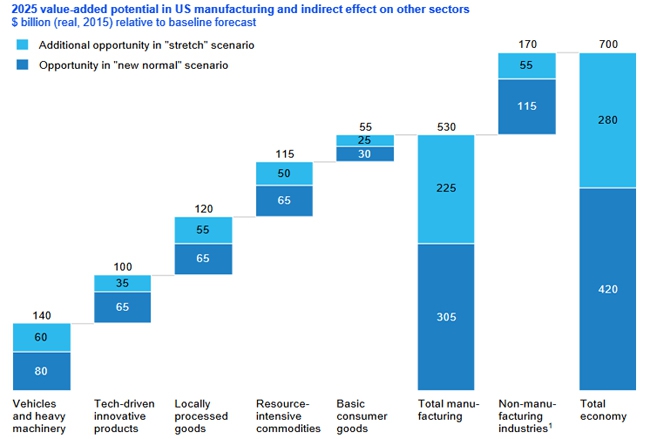The McKinsey Global Institute released new research this week that outlines opportunities to boost manufacturing by up to $530 billion, or 20 percent, over current trends by 2025—and create more than 2 million jobs. The report, Making it in America: Revitalizing US manufacturing, also provides fresh details on why the US manufacturing sector has suffered steep declines.
The research found that the largest US firms have successfully navigated the challenges of the past two decades, even outperforming their counterparts around the globe. But while the largest US firms have seen their domestic revenues grow more than twice as fast as the sector average even in the domestic market, their smaller suppliers have lost considerable ground. Some tier-one suppliers to major manufacturers are performing well, but tier-two and -three suppliers in many industries are struggling.
“The hollowing out of the supplier base now leaves larger manufacturers vulnerable to global supply chain risk and lacking a healthy domestic ecosystem that could provide resilience and opportunities for innovation,” stated Katy George, report coauthor and managing partner of McKinsey's Mid-Atlantic office. “More broadly, the decline of manufacturing has diminished prospects for the US middle class. Our analysis finds that it contributed two-thirds of the recent fall in labor's share of US GDP.”
However, the study cites opportunities to turn things around.
“Demand is rising both at home and abroad—and there is enormous room to grow exports, since less than 1 percent of US firms sell into international markets, a far lower share than in any other large advanced economy,” stated Sree Ramaswamy. “Value chains are evolving to US advantage, particularly for firms in advanced industries and their suppliers. New business models are becoming possible as value shifts from production to R&D, design, and services. Favorable changes in relative labor and energy costs provide a tailwind.”
If US manufacturers take full advantage of Industry 4.0 technologies and trends, manufacturing GDP would climb to $3 trillion in real terms by 2025—a boost of some $530 billion, or 20 percent, above the current trend.
“Capturing these opportunities will not be easy,” Ramaswamy stated. “The manufacturing sector needs new capabilities and investment, and more firms need to participate in exports in order to bring the benefits of global trade to more US workers. Aging plants and equipment, especially in the supply chains of advanced industries, will have to be upgraded for digital readiness. The sector needs new digital and technical skills from its workforce, and US-based manufacturers need to be as attractive to high-caliber talent as their foreign competitors.”
Edited from information by McKinsey Global Institute. An overview of the report, including PDF links to an executive summary and the full report, is here.








